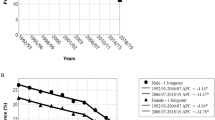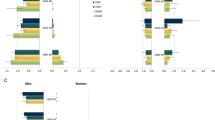Abstract
Based on two rounds of a nationally representative household survey, this paper presents an exploratory study of risk factors and the economics of the decision to smoke by adults in Russia in the second half of the 1990s. With an overall smoking prevalence of 32.2%, smoking is much more prevalent among men (61.4%) than among women (10.3%). The risk of smoking is on the rise in Russia due mainly to the growing incidence of female smoking, especially in major urban centres, where the impact of modern culture and Western tobacco companies is more profound. The low estimated price elasticities of the decision to smoke for men (−0.085) and for women (−0.628) suggest that an excise tax on cigarettes is not an effective means to reduce the prevalence of smoking. The decision to smoke is also found to be very income inelastic. Formal education, occupation, alcohol consumption, and obesity are associated with smoking in a way similar to developed countries.
Similar content being viewed by others
Notes
1 The survey has been coordinated by the Carolina Population Center (CPC) at the University of North Carolina at Chapel Hill in collaboration with Paragon Research International and the Russian Academy of Sciences. The following outline of the RLMS sampling techniques draws on the detailed project descriptions provided by the CPC team (http://www.cpc.unc.edu/projects/rlms/project.html). The data may be obtained from the RLMS Web site (http://www.cpc.unc.edu/projects/rlms/data.html).
2 The price indices are computed from the RLMS household data as follows.

where FPI ry is the Food Price Index in PSU r in year y, r={1, 2,…, 38}, y={1996, 1998}, p ry g is the average price of item g paid by household in PSU r in year y, g={1, 2,…, 25}, q b g is the quantity of item g in the food basket, and p b g is the average price of item g paid by Russian households in the Fall of 1996. The composition of the food basket is determined based on the quantities of items g bought by an average Russian household in the Fall of 1996. The PSU price indices and technical details of their calculation are available from the authors on request.
3 Despite the fact that because of higher female life expectancy (around 72 years while male life expectancy is around 60 years), an average adult woman is 4 years older than an average adult man, an average female smoker is about 6 years younger than an average male smoker. The average duration of smoking among current smokers is about 15 years for women and 24 years for men. Among those who ever smoked, quitters account for 36.6% of women and only for 23.4% of men. The average duration of smoking for quitters is about 9 and 22 years for women and men, respectively.
4 A papirosa is a shorter but somewhat thicker variant of an unfiltered cigarette with a short paper pipe attached.
5 Likelihood ratio tests confirmed our supposition that influences on the decision to smoke are gender specific. The null hypothesis (ie that the slope coefficients in the male and female equations are equal) was rejected at the 99% confidence level.
6 This formula is derived from the following definition of elasticity: ɛ V = ∂S/S : ∂V/V = ∂S/∂V · V/S, where S = Φ(α′z i ) and ∂S/∂V = φ(α′z i )[∂(α′z i)/∂V] at the means of the regressors. Since ∂(α′z i )/∂V = ∂(α V ln V)/∂V = α V /V, ɛ V = [φ(α′ z i )α V /V][V/S] = φ (α′ z i )α V /S. The formula assumes constant (Cobb–Douglas type) elasticity.
7 The likelihood ratio tests showed no differences in the coefficients of the explanatory variables between Rounds 7 and 8 (failed to reject the null hypothesis at the 95% confidence level).
8 This does not contradict the data in Table 1, which show no significant changes in the percentages of smokers from 1996 to 1998, because the percentages in Table 1 also reflect the negative influence of other factors (particularly a more than 80% increase in cigarette prices), which are controlled for in the probit model.
9 Calculated as g = (ΔS/S)100, where ΔS is the marginal effect of Round 8, φ (α′z i )α R , and S = Φ(α′z i is estimated at the means of the regressors.
10 The 1.375 coefficient of the gender dummy variable (1 if male) in the model with pooled genders is significant at the 0.01 level and the estimated marginal effect of the male gender on the probability of being a smoker is 0.487.
11 This budget effect is also visible if we calculate price elasticities of the decision to smoke separately for 1996 and 1998. In 1996, these elasticities were −0.046 and −0.430, while in 1998 they were −0.120 and −0.919 for men and women, respectively. The greater sensitivity of the decision to smoke to cross-section price differences in 1998 may be explained by the fact that in 1998 the (geometric) average real cigarette price was more than 80% higher than that in 1996 and therefore the fraction of household income spent on cigarettes was greater in 1998. This difference in elasticity, however, does not appear to be statistically significant given the standard errors of the corresponding probit estimates.
12 The marginal effects of age are calculated as ∂S/∂A = φ (α′z i )(α A + 2α A2 A), where S is the probability of being a smoker, A is age, φ(·) is estimated at A and the means of other regressors, α A and α A2 are the probit coefficients of age and age square, respectively.
13 Education and occupation are likely to be correlated. Our likelihood ratio tests showed, however, that, for both genders, neither of these factors can be omitted without losing the model's explanatory power (the null hypothesis is rejected at the 99% confidence level). That is, both education and occupation contribute significantly to explaining the probability of being a smoker. Yet, for men, education appears to take priority over occupation. The exclusion of education leads to a lower likelihood ratio index than does the exclusion of occupation (0.118 compared to 0.128). For women education and occupation appear to be of the same importance.
14 Unfortunately, the RLMS data limitations do not allow us to examine teenage smoking. In the survey, most teenagers were interviewed using the Child Questionnaire, which did not include questions on smoking.
15 On 8 Feburary 2001, the Lower House of the Russian parliament recognised the health threat and voted to ban tobacco advertising in print media, billboards and public transportation. On 14 January 2002, Article 6 of the federal law on limitation of tobacco smoking (to be activated after six months following its publication) forbade smoking in public transportation facilities, at work, on aircraft during flights of less than 3 h, in enclosed sport facilities, in organisations specialised in the field of health, education, and culture and in all buildings where state institutions are represented (RFE/RL, 2002).
References
CDC MMWR Weekly, 1999: 48(43): 993–996. November 5, 1999.
Chaloupka, FJ and Warner, KE . 1999: The economics of smoking, NBER Working paper 7047, March 1999.
DaVanzo, J and Grammich C . 2001: Dire demographics: Population trends in the Russian Q1Federation. RAND. Online Publication (http://www.rand.org/publications/MR/MR1273/).
Farrell, P . 1986: Schooling and health: The cigarette connection. In: Victor R.F. (ed). The Health Economy. Harvard University Press: Cambridge, MA.
Gruber, J and Zinman, J . 2000: Youth smoking in the US: Evidence and implications. NBER Working paper W7780, July 2000.
Hu, T-W, Ren, Q-f, Keeler, TE and Bartlett, J . 1995: The demand for cigarettes in California and behavioural risk factors. Health Economics 4: 7–14.
Interfax, May, 2001.
Johnson, JG, Cohen, P, Pine, DS, Klein, DF, Kasen, S and Brook, JS . 2000: Association between cigarette smoking and anxiety disorders during adolescence and early adulthood. Journal of the American Medical Association 284(18): 2348–2351.
Leon, D and Shkolnikov, V . 1998: Social stress and the Russian mortality crisis. Journal of the American Medical Association 279: 790–791.
Lopez, AD . 1997: Mortality from tobacco in the new independent states. In: Bobadilla, JL, Costello, CA, and Mitchell, F (eds). Premature Death in the New Independent States. National Academy Press: Washington, DC.
Lugesen, M and Meads, C . 1991: Tobacco advertising restrictions, price, income and tobacco consumption in OECD countries, 1960–1986. British Journal of Addiction 86: 1343–1354.
McKee, M, Bobak, M, Rose, R, Shkolnikov, V, Chenet, L and Leon, D . 1998: Patterns of smoking in Russia. Tobacco Control 7: 22–26.
Monitoring Economic Conditions in the Russian Federation. 2002: The Russia Longitudinal Monitoring Survey 1992–2001. University of North Carolina at Chapel Hill, April 2002.
Moore, MJ and Hughes, JW . 2000: The health care consequences of smoking and its regulation. University of Virginia/Bates College, Working paper, October 2000.
Notzon, FC, Komarov, YM, Ermakov, SP et al. 1998: Causes of declining life expectancy in Russia. Journal of the American Medical Association 279: 793–800.
Peto, R, Lopez, AD, Boreham, J et al. 1994: Mortality from smoking in developed countries 1950–2000. Oxford University Press: Oxford.
Prokhorov, AV and Alexandrov, AA . 1992: Tobacco smoking in Moscow school students. British Journal of Addiction 87: 1469–1476.
Prokhorov, AV . 1997: Cigarette smoking and priorities for tobacco control in the new independent states. In: Bobadilla, JL, Costello, CA and Mitchell F. (eds). Premature Death in the New Independent States. National Academy Press: Washington, DC.
RFE/RL Newsline. 2002: Smoking forbidden in Russian public areas. 6(8): Part I, 14 January 2002.
Stone, R . 2000: Stress: The invisible hand in Eastern Europe's death rates. Science 288: 1732–1733.
Acknowledgements
We thank all participants at the Georgia Southern University's economics research seminar in October 2000 and Timothy Brock (The Ohio State University) for their comments.
Author information
Authors and Affiliations
Rights and permissions
About this article
Cite this article
Ogloblin, C., Brock, G. Smoking in Russia: The ‘Marlboro Man’ Rides but Without ‘Virginia Slims’ for Now. Comp Econ Stud 45, 87–103 (2003). https://doi.org/10.1057/palgrave.ces.8100001
Published:
Issue Date:
DOI: https://doi.org/10.1057/palgrave.ces.8100001





